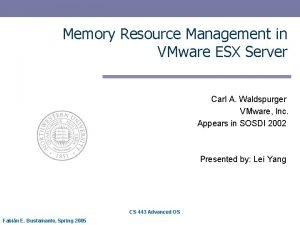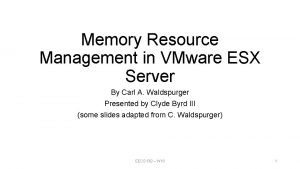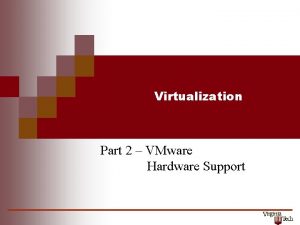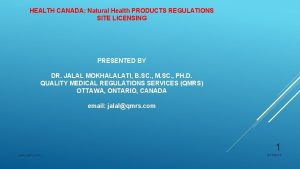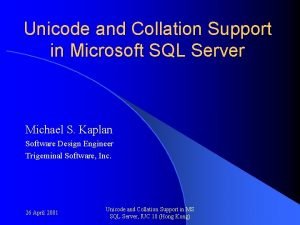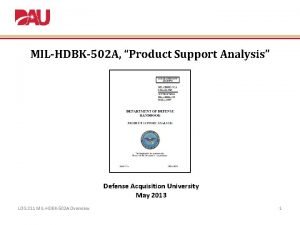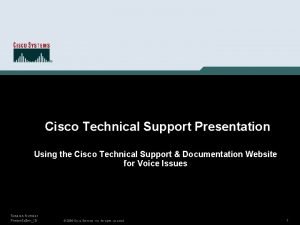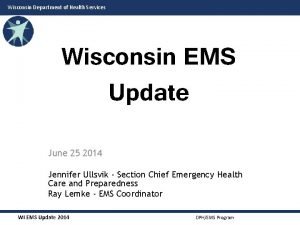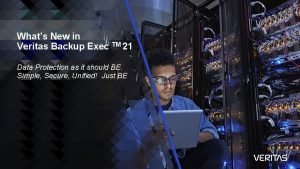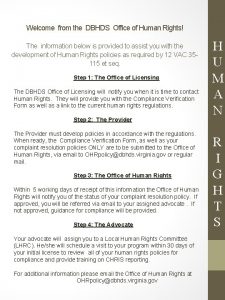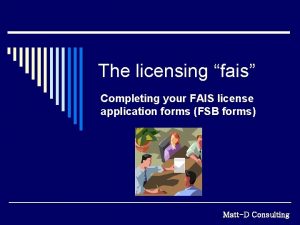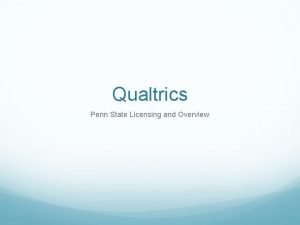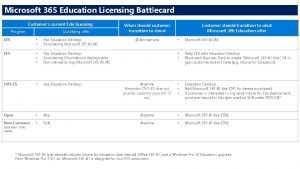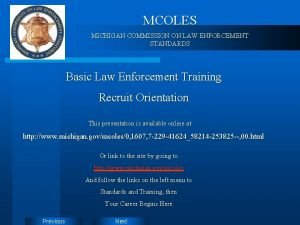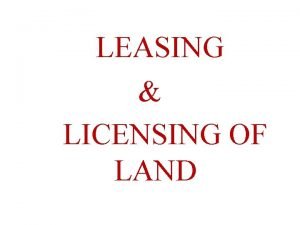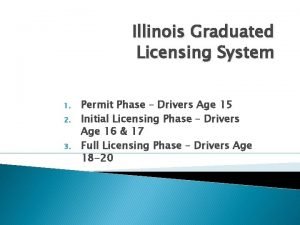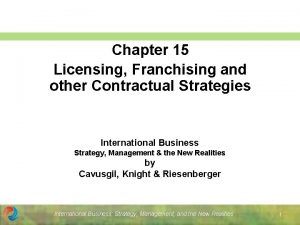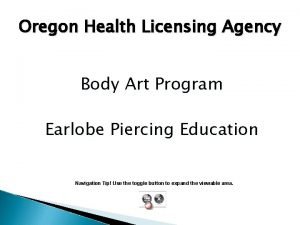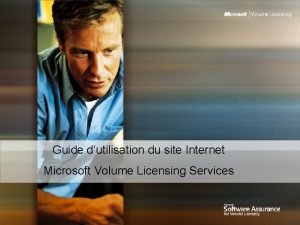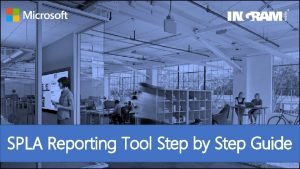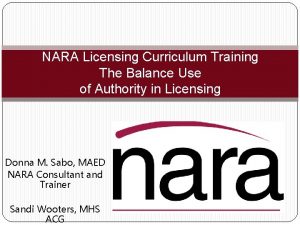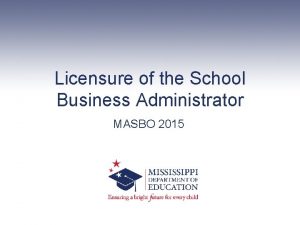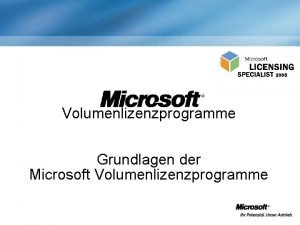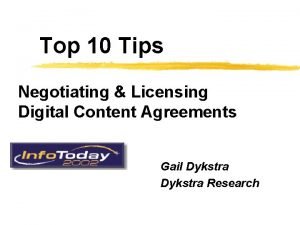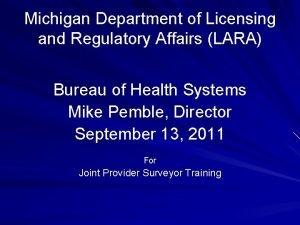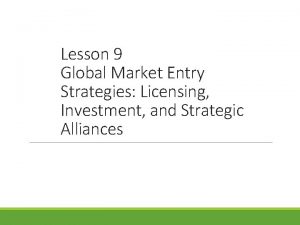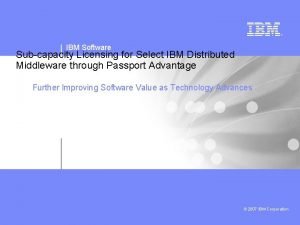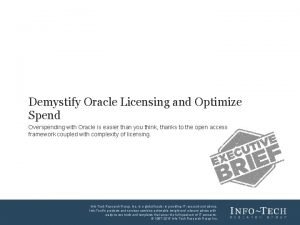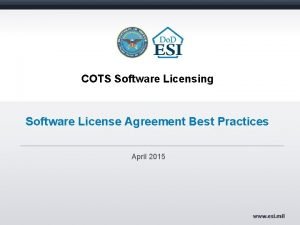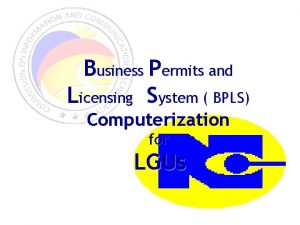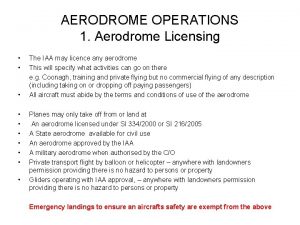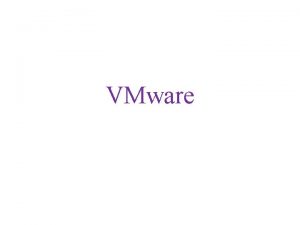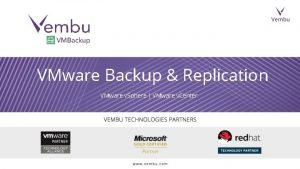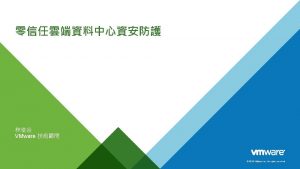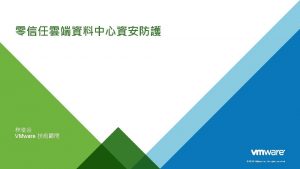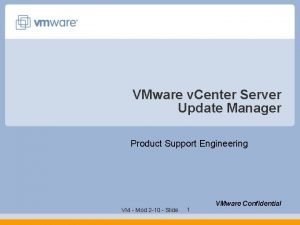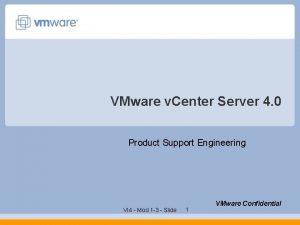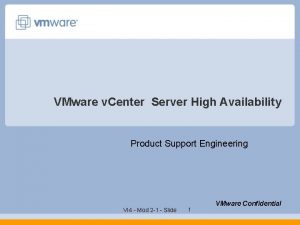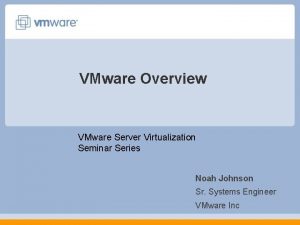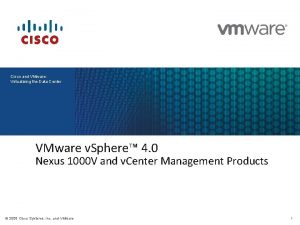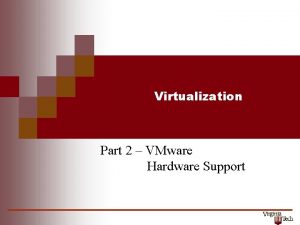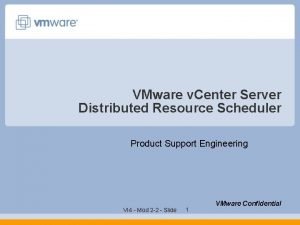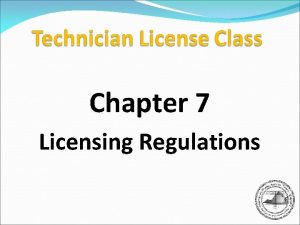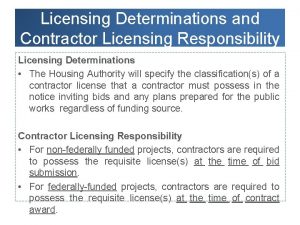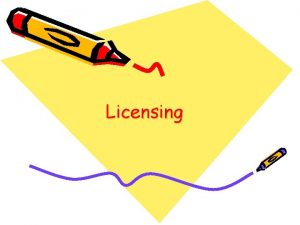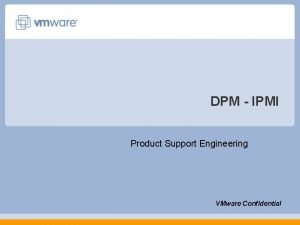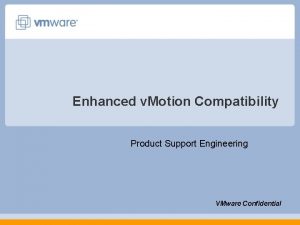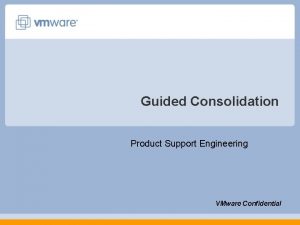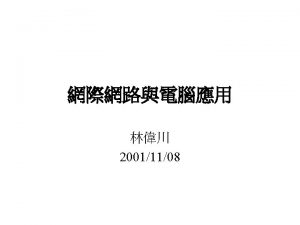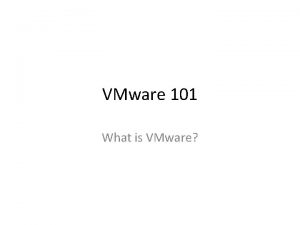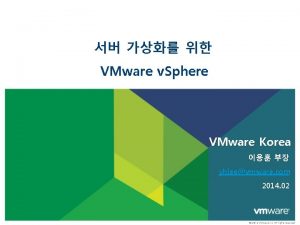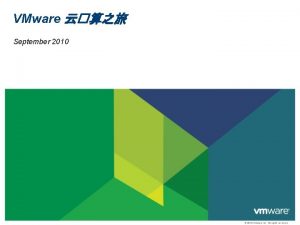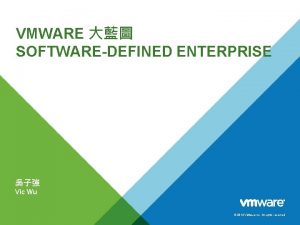VMware v Center Server Licensing Product Support Engineering













































- Slides: 45

VMware v. Center Server Licensing Product Support Engineering VMware Confidential

Module 1 -4 Lessons Lesson 1 – v. Sphere Upgrade Lesson 2 – ESX 4. 0 Install Lesson 3 – v. Center Server 4. 0 Lesson 4 – v. Sphere 4. 0 Licensing Lesson 5 – Remote CLI VI 4 - Mod 1 -4 - Slide 2

Module 1 -5 Lessons Lesson 1 – Overview of ESX 4. 0 Licensing Lesson 2 – License Management for Legacy hosts Lesson 3 – Configure Licensing for Legacy Hosts Lesson 4 – Managing VC 4. 0 Licenses Lesson 5 – Troubleshooting Licenses VI 4 - Mod 1 -4 - Slide 3

Serial Number Breakdown Type ESX VC Product VMODL Key ESX Enterprise esx. Enterprise ESX Standard esx. Full ESX Foundation esx. Express ESX Standalone esx. Basic ESX VDI esx. Vdi Virtual. Center Server vc Virtual. Center Foundation Server Features (VMODL Key) Limitations nas, vsmp, san, iscsi, backup, max. Vcpus. Per. Vm=8 esx. Host, das, drs, vmotion, ft, mpio, hotplug, hostprofile, dvs, vmsafe, dvfilter, svmotion, hostcluster nas, vsmp, san, iscsi, backup, max. Vcpus. Per. Vm=8 esx. Host, das, hotplug, vmsafe, dvfilter nas, vsmp, san, iscsi, backup, max. Vcpus. Per. Vm=8 esx. Host, hotplug, vmsafe, dvfilter nas, vsmp, san, iscsi max. Vcpus. Per. Vm=2 nas, vsmp, san, iscsi, backup, esx. Host, das, drs, vmotion, ft, mpio, hotplug, hostprofile, dvs, vmsafe, dvfilter, svmotion, hostcluster federation, woe max. Vcpus. Per. Vm=8 max. HOST=3 vc. Express VI 4 - Mod 1 -4 - Slide 4

Serial Number Breakdown Product ESX VC Feature nas vsmp san iscsi Description NAS VSMP SAN ISCSI backup Consolidated Backup esx. Host VC Agent for ESX Server das drs vmotion ft HA DRS VMotion Fault Tolerance memplus Memory Overcommit mpio MPIO / Third-Party Multi-Pathing hotplug Hot-Pluggable Virtual HW hostprofile Host Profiles dvs Distributed Virtual Switch vmsafe dvfilter svmotion VMsafe DVfilter Storage VMotion storemon Storage Utilization Monitoring hostcluster Host Cluster Features federation VC Federation woe Workflow Orchestration Engine Edition Addon 1 Addon 2 Addon 3 Addon 4 Addon 5 ESX Enterprise ESX Standard vmotion svmotion drs ft hostprofile ESX Foundation das vmotion svmotion drs ft ESX Standalone esx. Host backup vmsafe dvfilter das VI 4 - Mod 1 -4 - Slide 5

Managing v. Sphere Licenses In v. Center Server 4. 0, license reporting and management are centralized You no longer need a license server or host license files if you have upgraded all your ESX hosts to 4. 0 All product and feature licenses are encapsulated in 25 character license keys that you can manage and monitor from v. Center Server 4. 0 Each ESX/ESXi host requires one license key. Each v. Center Server instance requires one license key. Two Editions - Foundation and Enterprise. The Enterprise edition includes VMware DRS, VMware HA, and VMotion. In a v. Center Server system, the Home > Licensing screen includes a Manage v. Sphere Licenses wizard that guides you through these tasks: Adding license keys to the inventory Assigning licenses to assets Unassigning licenses Removing license keys from the inventory VI 4 - Mod 1 -4 - Slide 6

Evaluation Mode for ESX 4. 0 can be installed and run in Evaluation Mode Evaluation mode is intended for demonstration and evaluation purposes Full functionality of ESX 4. 0 for 60 days from the time you install During the evaluation period, the software notifies you of the time remaining until the evaluation expires ESX Enterprise evaluation mode allows you to use VMware VMotion, VMware High Availability, VMware Distributed Resource Scheduler 60 -day evaluation period begins to count down immediately after the first time you power on the ESX machine VI 4 - Mod 1 -4 - Slide 7

Licensing ESX After the Evaluation Period Expires After 60 -day evaluation period expires You are no longer able to perform most operations in ESX You cannot power on virtual machines, add new hosts , or use advanced ESX features Hosts are disconnected from the v. Center Server system if the evaluation period expires before you assign a license NOTE Reinstalling the v. Center Server after the 60 -day evaluation expires does not restart the evaluation period from the beginning. VI 4 - Mod 1 -4 - Slide 9

Configure Virtual. Center to Use Evaluation Mode When you run Virtual. Center in evaluation mode, v. Center 4. 0 behaves for 60 days as if it has a Virtual. Center Server edition license. The Virtual. Center Server and evaluation editions of Virtual. Center allow you to manage an unlimited number of hosts and use Linked-Mode Virtual. Center. To configure Virtual. Center to use evaluation mode If you install Virtual. Center and do not enter a license key during the installation, Virtual. Center is installed in evaluation mode. When the install wizard prompts you for a license key, leave the license-key field blank. VI 4 - Mod 1 -4 - Slide 10

License Management for Legacy Hosts ( ESX 3. x ) Flex. LM License Server is required to manage ESX 3. x/ESXi 3. 5 hosts in v. Center Server 4. 0 must be configured with the Flex. LM license server connection details When you add an ESX 3. x/ESXi 3. 5 host to the v. Center Server 4. 0 inventory, v. Center Server checks out v. Center Server Agent licenses from the Flex. LM license server. The license server also manages VMware VMotion, VMware Distributed Resources, VMware High Availability, and VMware Consolidated Backup licenses for ESX 3. x/ESXi 3. 5 hosts. The Flex. LM License Server can be installed from a VC 2. 5 CD VI 4 - Mod 1 -4 - Slide 11

Configure a Legacy License Server for v. Center Server 4. 0 Before you begin this procedure, Make sure that v. Center Server is licensed by choosing Home > Licensing. If v. Center Server is in evaluation mode or is unlicensed, click Manage v. Sphere Licenses and assign a license key to v. Center Server Host-Based License Files for Legacy Hosts If your ESX 3. x and ESXi 3. 5 hosts have host-based license files, you can continue to use the license files. However, host-based license files are not a substitute for the license server that is required by v. Center Server 4. 0 when v. Center Server is managing legacy hosts. VI 4 - Mod 1 -4 - Slide 12

Configure a Legacy License Server for v. Center Server From the VI Client, select Administration > v. Center Server Settings Click Licensing in the list on the left. Select a v. Center Server from the Current v. Center menu. Under License Server, enter the fully qualified domain name or the IP address of the license server and, optionally, a port. If you do not specify a port, the default port, 27000, is used. Select Reconfigure ESX 3 hosts using license servers to use this server if you want each ESX 3. x/ESXi 3. x host that you add to the v. Center Server inventory to use the same license server as this v. Center Server. VI 4 - Mod 1 -4 - Slide 13

License Reporting for v. Sphere 3 On the v. Center Server 4. 0 Home > Licensing screen, you can monitor Virtual Infrastructure 3 license information. Populating and displaying legacy host information requires polling of the license server Displaying legacy host information might take more time than displaying ESX 4. 0/ESXi 4. 0 host information VI 4 - Mod 1 -4 - Slide 14

Monitoring License Information In v. Center Server 4. 0, you can view Virtual Infrastructure 3 and v. Sphere 4 license inventory data by: Product – A product is a license to use a v. Sphere software component or feature. For example: p v. Sphere 4 ESXi Enterprise (1 -4 cores per CPU) p v. Sphere 4 v. Center Server Enterprise VI 4 - Mod 1 -4 - Slide 15

Monitoring License Information License key – A license key is the serial number that corresponds to a product. Asset – An asset is a ESX or v. Center on which a product is installed. For an asset to run certain software legally, the asset must be licensed to do so. The license report displays licensed assets only. The report does not display assets that are unlicensed. You can split some license keys by applying them to multiple assets. For example you can split a 4 -CPU license by applying it to two 2 -CPU hosts. VI 4 - Mod 1 -4 - Slide 16

Label a License Key When you view licenses in the report, you can add an optional description of each license key or of a set of license keys. These labels appear and are editable in the license report. By default, the label field is empty. To add or change a label 1 From a v. Sphere Client host that is connected to v. Center Server, click Home > Licensing. 2 Click View by Product or License key. 3 Select a license key. If you are viewing the report by product, click a product to expand the list of associated license keys and select a license key. 4 Click the label field and enter a new label. VI 4 - Mod 1 -4 - Slide 17

Export Report Data You can export license data to a file. To export license inventory data From a v. Sphere Client host that is connected to v. Center Server, click Home > Licensing. Select the view that you want to export: Product, License key, or Asset. From the report screen, click Export. VI 4 - Mod 1 -4 - Slide 18

Export Report Data In the save-as dialog box, select a folder, a file name, and a format for the exported license data and click Save. VI 4 - Mod 1 -4 - Slide 19

Managing Licenses Centrally You can manage all of your v. Sphere 4 licenses from a single location using v. Center Server. In v. Center Server, the licensing administration page includes a Manage v. Sphere Licenses wizard that guides you through these tasks: Adding license keys to the license inventory Assigning licenses to assets Unassigning licenses Removing license keys from the license inventory VI 4 - Mod 1 -4 - Slide 20

Add License Keys The Manage Licenses wizard allows you to add multiple license keys in a single procedure or add one license key at a time. To add license keys From a v. Sphere Client host that is connected to v. Center Server, click Home > Licensing. Click Manage v. Sphere Licenses. In the Add License Keys text area, enter license keys one per line. Type a brief description of the key or keys. VI 4 - Mod 1 -4 - Slide 21

Add License Keys Click Add License Keys. The wizard validates the keys. If any of the keys are invalid, an error message lists the invalid keys according to the invalid condition, which can be: Existing keys – The license key already exists in the v. Center Server inventory. Expired keys – The license key is valid but expired. Invalid keys – The license key is missing characters, has too many characters, or its characters are ordered improperly. VI 4 - Mod 1 -4 - Slide 22

Add License Keys Assign license keys to assets Select ESX or v. Center and in the Product window select an appropriate license key Click Next through the remaining wizard screens and click Finish to save your changes. VI 4 - Mod 1 -4 - Slide 23

Search for Assets You can search for assets that you want to apply licenses to. You can search based on the following criteria: Asset name License key VI 4 - Mod 1 -4 - Slide 24

Search for Assets To narrow the list of selectable assets From a v. Sphere Client host that is connected to v. Center Server, click Home > Licensing. Click Manage v. Sphere Licenses. To skip the Add License Keys screen, click Next. Type search terms into the Search for assets text area and press the Enter key. Each asset with matching criteria appears in the list of selectable assets. Click the ESX or v. Center Server tab to display the available assets that match your search term. VI 4 - Mod 1 -4 - Slide 25

View the Current Status of an Asset To view the status of an asset From a v. Sphere Client host that is connected to v. Center Server, click Home > Licensing. Click Manage v. Sphere Licenses. To skip the Add License Keys screen, click Next. Click the ESX or v. Center tab to display the available assets. Rest your mouse cursor over an asset to view the current status. VI 4 - Mod 1 -4 - Slide 26

Unlicense an Asset To unlicense an asset From a v. Sphere Client host that is connected to v. Center Server, click Home > Licensing. Click Manage v. Sphere Licenses. On the Assign Licenses screen, select an asset. Click the ESX and v. Center tabs to display the asset types. In the Product window, click Unlicensed and click Next. Click Next to skip the Remove License screen. If you retain the license, you can assign it to another asset. Click Finish to save your changes. VI 4 - Mod 1 -4 - Slide 27

Remove License Keys You can remove license keys that are not assigned to any assets from the v. Center Server inventory. Reasons to remove a license include: The license key has expired. You have used the licensing portal to combine the capacities of multiple fragmented licenses and you need to remove the zerocapacity licenses. You have upgraded your licenses and you need to remove the legacy licenses. VI 4 - Mod 1 -4 - Slide 28

Remove License Keys From a v. Sphere Client host that is connected to v. Center Server, click Home > Licensing. Click Manage v. Sphere Licenses. Click Next twice to go to the Remove License Keys screen. Select the license to remove it from the inventory and click Next. By default, this screen displays only license keys that are not assigned to any assets. Click Finish VI 4 - Mod 1 -4 - Slide 29

Managing Licenses Individually 1. From the v. Sphere Client, select the host in the inventory. 2. Click the Configuration tab. 3. Under Software, click Licensed Features. 4. Click Edit. 5. Select Assign a new license key to this host, click Enter Key, and enter a license key and an optional label for the license key. 6. Click OK. VI 4 - Mod 1 -4 - Slide 30

Serial Number Breakdown Serial Number Licensing In v. Sphere we completely removed the FLEX licensing system (except as noted below) v. Sphere uses serial numbers to license both VC and ESX p Each ESX system is licensed using one serial number p Each instance of VC is licensed using one VC serial number p VC can also manage ESX serial numbers and can license ESX systems by pushing down the serial number p VC becomes the license manager replacing the FLEX license server Note: If the v. Sphere environment also includes ESX 3. 5 hosts, a FLEX License Server is still required VI 4 - Mod 1 -4 - Slide 31

Serial Number Breakdown Serial Number Licensing (continued) Serial number licensing relies on two components: Serial number Dormant license file (DLF) The customer enters the serial number into the product This unlocks the dormant license file to which the serial number maps The serial number describes customer specific information: CPU count, support-level, expiration date, etc. The dormant license file describes product specific information: Edition, v. SMP support (max v. CPUs/VM), licensed features (VMotion, i. SCSI, DRS etc. ) etc. VI 4 - Mod 1 -4 - Slide 32

Serial Number Breakdown Dormant License File Details On ESX dormant license files reside in: /usr/lib/vmware/licenses/site/ On VC dormant license files for VC & ESX reside in: C: Program FilesVMwareInfrastructureVirtual. Center Serverlicensessite VI 4 - Mod 1 -4 - Slide 34

Serial Number Breakdown ESX 1 Virtual. Center Server VC Serial Number xxxxx-xxxxx-xxxxx VC DLF ESX 2 VI (ESX) Serial Number yyyy-yyyyy-yyyyy ESX DLF ESX 3 VI 4 - Mod 1 -4 - Slide 35

Serial Number Breakdown Additional v. Sphere Changes Add-on Licenses In v. Sphere, licensing capabilities are associated with an edition, not broken down into feature-based licenses as it was with FLEX Each serial number maps to a dormant license file that describes the capabilities of the edition VI 4 - Mod 1 -4 - Slide 36

Serial Number Breakdown Additional v. Sphere Changes (continued) Add-on Licenses (continued) v. Sphere also calls for the ability to buy an edition and then add features (e. g. Foundation + VMotion) all using the same serial number p Add-on features are encoded in the serial number using the 5 “reserved” bits p The licensed capabilities are therefore: p The features granted by the edition Plus p All add-on features encoded in the serial number VI 4 - Mod 1 -4 - Slide 37

Serial Number Breakdown Example ESX DLF # VMware software license Start. Fields = "Cpt, Product. ID, License. Version, License. Type, License. Edition, Option, Epoch" Cpt = "COPYRIGHT (c) VMware, Inc. 1999 -2008" Product. ID = "VMware ESX Server" License. Version = "4. 0" License. Type = "Site" Epoch = "2008 -3 -1" License. Edition = "esx. Enterprise" Option = "7" Data = "capacity. Type=cpu. Package: 6 core; enable=nas, vsmp: 8, san, iscsi, backup, vmotion, das, drs, esx. Host, ft, mpio, hotplug, hostprofile, dvs, vmsafe, dvfilter, svmotion; desc=v. Sphere Enterprise" Data. Hash = "a 0301 bd 7 -24 ca 5857 -3 dcf 9 a 37 -c 77 ab 7 c 0 -f 930 f 835" Hash = "509 ffd 42 -c 589 afc 5 -de 222652 -412 de 1 a 9 -41894 b 7 e" VI 4 - Mod 1 -4 - Slide 42

Serial Number Breakdown Example VC DLF # VMware software license Start. Fields = "Cpt, Product. ID, License. Version, License. Type, License. Edition, Option, Epoch" Cpt = "COPYRIGHT (c) VMware, Inc. 1999 -2008" Product. ID = "VMware Virtual. Center Server" License. Version = "4. 0" License. Type = "Site" Epoch = "2008 -3 -1" License. Edition = "vc" Option = "7" Data = "capacity. Type=server; enable=linkedvc, woe; desc=v. Center Server; mdate=2008 -11 -19" Data. Hash = "bd 0 c 5 c 99 -600797 d 5 -6 fb 55898 -baf 9 fe 4 a-e 0519112" Hash = "8 c 32 ab 91 -fb 372347 -dc 3 e 5 fc 1 -20 c 072 f 7 -7 ff 8 cd 9 e" VI 4 - Mod 1 -4 - Slide 43

Managing VMware Legacy Hosts (ESX 3. x/ESXi 3. 5) The troubleshooting scenarios in this section apply to mixed environments, in which v. Center Server 4. 0 is managing legacy ESX 3. x/ESXi 3. 5 hosts. Check the License Server If v. Center Server is managing legacy hosts, v. Center Server must check out v. Center Server Agent licenses from the license server. If v. Center Server is having trouble communicating with your license server, check the following: p Check that the license server Windows service is running. p Check that license server is listening. p Check the license server status. VI 4 - Mod 1 -4 - Slide 46

Managing VMware Legacy Hosts To check that the license server Windows service is running 1 On the machine on which the license server is installed, select Start > Control Panel > Administrative Tools > Services to display the Services control panel. 2 Verify that the Status column for the VMware License Server entry reads Started. 3 If the VMware License Server is not started, right-click the service and select Start. VI 4 - Mod 1 -4 - Slide 47

Check That the License Server is Listening To check that the license server is listening On the machine on which the license server is installed, select Start > Command Prompt. Type netstat -ab at the command line. Verify that the lmgrd. exe process is listening on port 27000 and that the VMWARELM. exe process is listening on port 27010. VI 4 - Mod 1 -4 - Slide 48

Check the License Server Status On the machine on which the license server is installed, select Start > Programs > VMware License Server Tools to launch the LMTOOLS utility. Click the Server Status tab to display the Server Status page. Click Perform Status Inquiry. License server information, including the location of the license file, appears at the bottom of the page. VI 4 - Mod 1 -4 - Slide 49

Check the License File If your license server is operating properly or if your legacy hosts are usingle-host licensing, but you cannot use licensed features, you have a problem with your license file. Validate your license file at http: //www. vmware. com/checklicense/ Ensure that you are using the correct type of license file. If you are using a license server, use a centralized file. If you are usingle-host licensing, make sure that you are using a single-host license file on each host. Centralized files contain a block of header text at the top, and the string ‘VENDOR_STRING=license. Type=Server’ appears in each license key in the file. Single-host license files have no header text, and the string ‘VENDOR_STRING=license. Type=Host’ appears in each license key in the file. VI 4 - Mod 1 -4 - Slide 50

Check the License File If you are using a centralized license file, check that the license type header information appears only once and at the top of the file. If you edited the license file, check that you did not mix centralized and single-host keys in a single file. Check that the license file contains the correct keys for the features you want to use. VI 4 - Mod 1 -4 - Slide 51

Lesson 1 - 4 Summary Learn how to License Legacy hosts in VI 4. 0 Learn how licensing works in VI 4. 0 License VC 4. 0 and ESX 4. 0 Hosts VI 4 - Mod 1 -4 - Slide 52

Lesson 1 - 4 - Lab 1 involves Licensing VC 4. 0 and ESX 4. 0 Hosts Setting up License Server for Legacy Hosts Licensing VC 4. 0 and ESX 4. 0 Hosts License Reporting VI 4 - Mod 1 -4 - Slide 53
 Vmware resource management
Vmware resource management Memory resource management in vmware esx server
Memory resource management in vmware esx server Vmware support hardware virtualization
Vmware support hardware virtualization Health canada site license application
Health canada site license application Unicode
Unicode Major and minor supporting details
Major and minor supporting details Signature product support
Signature product support Mil-hdbk-502a
Mil-hdbk-502a Cisco product support
Cisco product support Wisconsin ems licensing
Wisconsin ems licensing Veritas vems
Veritas vems Dbhds office of human rights
Dbhds office of human rights Fais licensing requirements
Fais licensing requirements Psu qualtrics login
Psu qualtrics login Qlik license types
Qlik license types Module 4 - open source software and licensing
Module 4 - open source software and licensing Microsoft education licensing
Microsoft education licensing Mcoles standards
Mcoles standards West calcasieu cameron 3767 baton rouge la 70821
West calcasieu cameron 3767 baton rouge la 70821 Licensing sports marketing
Licensing sports marketing 2005/lml/18/8
2005/lml/18/8 Industries requiring compulsory licensing *
Industries requiring compulsory licensing * During the initial licensing phase
During the initial licensing phase Utah department of health child care licensing
Utah department of health child care licensing Licensing franchising and other contractual strategies
Licensing franchising and other contractual strategies Mary washington bookstore
Mary washington bookstore Oregon health licensing agency
Oregon health licensing agency Microsoft mvls
Microsoft mvls Microsoft spla reporting software
Microsoft spla reporting software Nara licensing
Nara licensing School business administrator licensing
School business administrator licensing Microsoft partner balingen
Microsoft partner balingen Export licensing requirements
Export licensing requirements Digital content licensing
Digital content licensing Georgia child care licensing regulations
Georgia child care licensing regulations Lara renew nursing license
Lara renew nursing license Entry strategy licensing
Entry strategy licensing Ibm sub capacity licensing
Ibm sub capacity licensing Entry strategy licensing
Entry strategy licensing Ga form 3231 blank
Ga form 3231 blank Exporting office essentials
Exporting office essentials Licensing and regulation division
Licensing and regulation division Oracle licensing workshops
Oracle licensing workshops Cots license
Cots license Bpls system
Bpls system Iaa licensing
Iaa licensing
